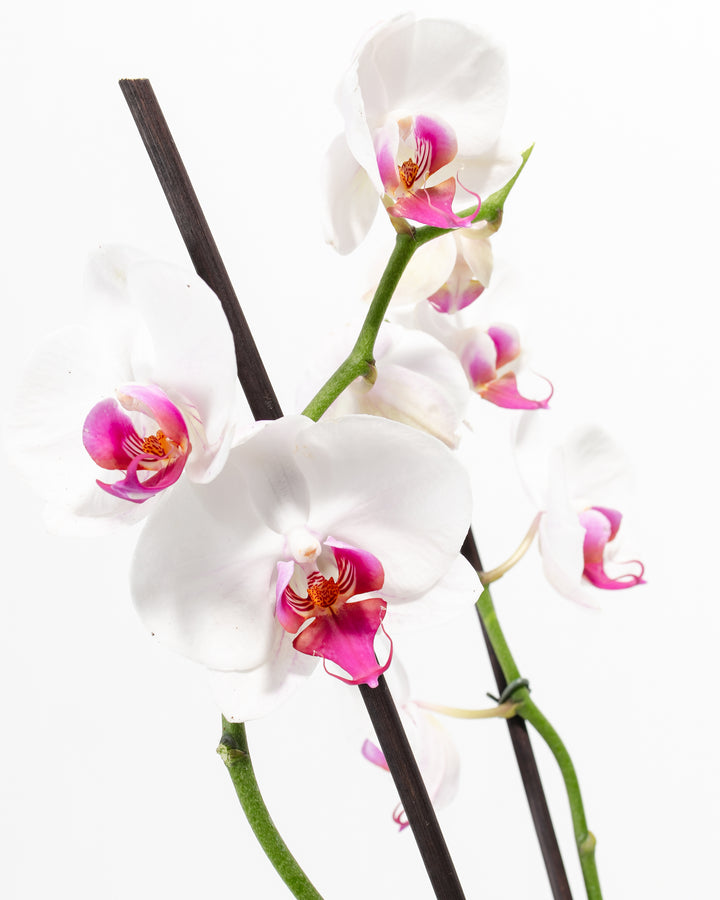Welcome
You have points
Recently viewed
Wishlist
Sign in to access your favorites

The Red Lip Moth Orchid (Phalaenopsis spp. ‘Red Lip’) is a beautiful indoor plant with glossy green leaves and slender flower stalks crowned with white blooms. Each flower has a bright red-pink central petal (called a lip). This red and white orchid is a popular flowering plant, belonging to the Phalaenopsis genus, one of the most popular and low-maintenance orchid varieties. Its stunning blossoms last for several months, providing a beautiful floral display. Mature Phalaenopsis orchids often bloom twice or even thrice a year.
Native to parts of Asia, the Philippines, Indonesia, and Australia, these magnificent epiphytes grow on trees in the wild. This moth orchid is most suitable for USDA hardiness zones 10-11 and thrives in locations with bright but filtered light. Once you know the basics of Phalaenopsis orchid care, it’s easy to grow, Moreover, orchids are safe to have around your pets, too.
White-colored orchids symbolize love, gracefulness, femininity, and beauty in various cultures. White orchids also stand for purity, peace, and humility.
Orchids come in a large variety of colors, from the delicately striped Arcadia Moth Orchid to the regal Purple Moth Orchid; you can also get Lively Root’s Orchid Bundle, which includes a trio of gorgeously colored plants.
Orchids are easy to grow, even if you’re a beginning plant enthusiast. Just follow our Moth Orchid care tips to keep your plant healthy and encourage more blooms:
Water your orchid thoroughly every 10 days or every week in warmer temperatures. It’s best to place your orchid into a tub filled with water for about 20 minutes and then let the water drain, as excess water can lead to root rot. Water more while the plant is in bloom.
Your white and red orchid will thrive in moderate to higher humidity (around 50%-70%). Group your orchid with other plants or use a humidifier if the air in your home is on the dry side.
Bright, indirect sunlight is best for your Phalaenopsis Red Lip orchid. Avoid placing your orchid in direct sunlight, though, as it can burn the plant’s leaves.
As tropical plants, orchids grow best in average room temperatures from 65°F to 80°F. Orchids prefer warmer temperatures during the day and cooler temperatures at night and don’t adapt well to sudden temperature changes.
The best soil for your red and white orchid should be well-draining and allow good air circulation around the roots. Add bark or coco coir to improve aeration.
Repot once every 2 years or when the soil becomes too easily saturated with water. The best time for repotting is right after your orchid stops flowering, as repotting during blooming can cause your orchid to shed its buds.
Feed your orchid with a balanced, diluted orchid fertilizer every 2-4 weeks during the growing season, giving it time to rest during late fall and winter.
Once your White Phalaenopsis Orchid is mature, you can propagate via division. Carefully disentangle the roots and pull them apart gently to form several new plants.
To remove dust, wipe the orchid’s leaves with a soft, damp cloth. Make sure to provide support for the flower stalks, especially as the buds start to form. Overwatering is one of the most common reasons for orchid problems, yellowing leaves. Make sure your orchid is never left sitting in water.
If your orchid’s not blooming, adjust its growing conditions to encourage blooms. Light is an important factor in making certain your orchid blooms well. Also, cooler temperatures in the fall can help make sure that your orchid will produce buds later in the season.
You can decorate with luxurious orchids for Christmas, use these lovely flowers as a dinner table centerpiece, or enjoy this plant’s colors and versatility with our Orchid Subscription.
Your Red Lip Moth Orchid will look stunning when combined with other colorful plants:
Some other gorgeous flowering plants to consider for your indoor garden include:
Bring glamor and allure to your holidays with a Red and White Moth Orchid for sale from Lively Root!
Follow us @livelyroot & show us your #livelyroot plants

